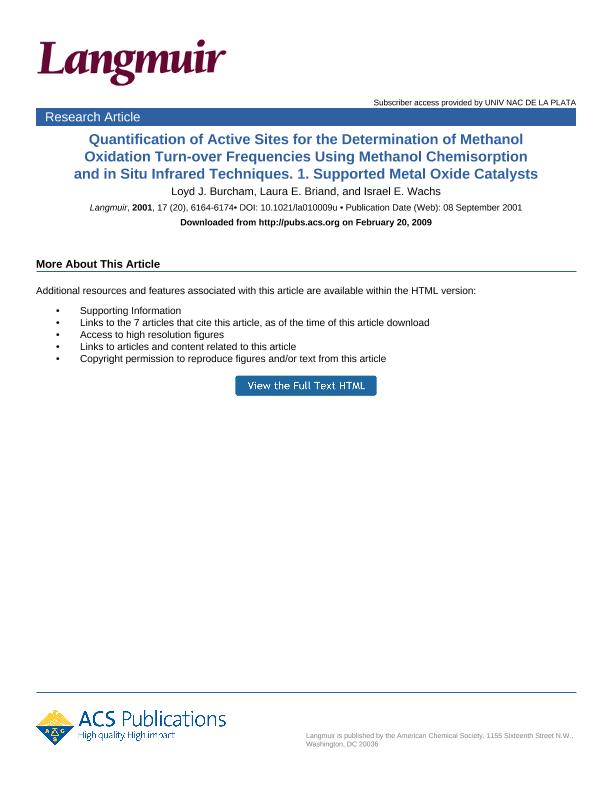Mostrar el registro sencillo del ítem
dc.contributor.author
Burcham, Loyd J.
dc.contributor.author
Briand, Laura Estefania

dc.contributor.author
Wachs, Israel E.
dc.date.available
2018-10-04T21:08:34Z
dc.date.issued
2001-10
dc.identifier.citation
Burcham, Loyd J.; Briand, Laura Estefania; Wachs, Israel E.; Quantification of active sites for the determination of methanol oxidation turn-over frequencies using methanol chemisorption and in situ infrared techniques. 1: Supported metal oxide catalysts; American Chemical Society; Langmuir; 17; 20; 10-2001; 6164-6174
dc.identifier.issn
0743-7463
dc.identifier.uri
http://hdl.handle.net/11336/61729
dc.description.abstract
Methanol oxidation over metal oxide catalysts is industrially important for the production of formaldehyde, but knowledge about the intrinsic catalysis taking place is often obscured by a lack of knowledge as to the number of active sites present on the catalyst surface. In the present study, the number of surface sites active in methanol oxidation has been determined over a wide range of supported metal oxide catalysts using quantitative methanol chemisorption and in-situ infrared titration techniques performed at an experimentally optimized temperature of 110 °C. It was found that a steric limitation of about 0.3 methoxylated surface species (e.g., strongly Lewis-bound CH3OHads and dissociatively adsorbed -OCH3,ads, which are the reactive surface intermediates in methanol oxidation) exists per active deposited metal oxide metal atom across all supported metal oxides. Hence, the use of methanol chemisorption for counting active surface sites is more realistic than other site-counting methods for the kinetic modeling of methanol oxidation, where during steady-state reaction the departure of the actual coverage of methoxylated surface intermediates from the maximum saturation surface coverage is of critical importance. Methanol oxidation turn-over frequencies (TOF = methanol molecules converted per second per active surface site) calculated using these new methanol chemisorption surface site densities increased by a factor of ∼3 the TOFs estimated in previous studies using the total number of deposited metal oxide metal atoms. Nevertheless, the support effect observed previously (TOFs for MoO3 and V2O5 supported on oxides of Zr ∼ Ce > Ti > Al ≫ Si) remains virtually unchanged as a general trend in the present study and correlates with the support cation electronegativity via bridging M-O-Support bonds. The methanol chemisorption technique may now be used with confidence to search for similar ligand effects in bulk metal oxides, where counting active sites has traditionally been very difficult (subject of part 2, Burcham, L.J.; Briand, L.E.; Wachs, I.E. Langmuir 2001, 17, 6175, of the present two-paper series).
dc.format
application/pdf
dc.language.iso
eng
dc.publisher
American Chemical Society

dc.rights
info:eu-repo/semantics/openAccess
dc.rights.uri
https://creativecommons.org/licenses/by-nc-sa/2.5/ar/
dc.subject
Methanol Oxidation
dc.subject
Tof
dc.subject
Surface Active Sites
dc.subject
Surface Science
dc.subject.classification
Otras Ingeniería Química

dc.subject.classification
Ingeniería Química

dc.subject.classification
INGENIERÍAS Y TECNOLOGÍAS

dc.title
Quantification of active sites for the determination of methanol oxidation turn-over frequencies using methanol chemisorption and in situ infrared techniques. 1: Supported metal oxide catalysts
dc.type
info:eu-repo/semantics/article
dc.type
info:ar-repo/semantics/artículo
dc.type
info:eu-repo/semantics/publishedVersion
dc.date.updated
2018-09-24T14:02:48Z
dc.journal.volume
17
dc.journal.number
20
dc.journal.pagination
6164-6174
dc.journal.pais
Estados Unidos

dc.journal.ciudad
Washington
dc.description.fil
Fil: Burcham, Loyd J.. Lehigh University; Estados Unidos
dc.description.fil
Fil: Briand, Laura Estefania. Consejo Nacional de Investigaciones Científicas y Técnicas. Centro Científico Tecnológico Conicet - La Plata. Centro de Investigación y Desarrollo en Ciencias Aplicadas ; Argentina
dc.description.fil
Fil: Wachs, Israel E.. Lehigh University; Estados Unidos
dc.journal.title
Langmuir

dc.relation.alternativeid
info:eu-repo/semantics/altIdentifier/doi/https://dx.doi.org/10.1021/la010009u
Archivos asociados
